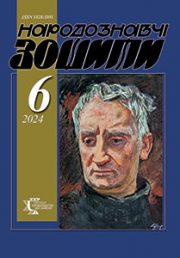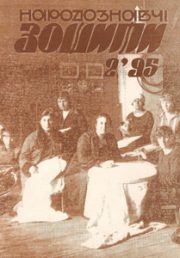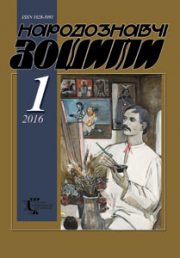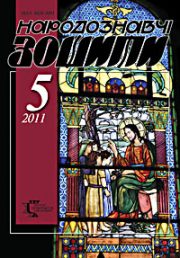The Ethnology Notebooks. 2023. № 4 (172), 964—977
UDK [394.46:94](477)”19/20″
DOI https://doi.org/10.15407/nz2023.04.964
IVANNIKOVA Lіudmyla
- ORCID ID: https://orcid.org/0000-0003-0617-5082
- Dr. Philology, Senior Scientific Worker,
- Rylsky Institute of Art Studies, Folklore and Ethnology,
- Ukrainian National Academy of Sciences,
- 4, Hrushevskoho str., 01001, Kyiv, Ukraine,
- Contacts: e-mail: ivannikovafolk@ukr.net
Abstract. In the last decade, a number of articles devoted to modern memorial and commemorative practices, collective and historical memory of places appeared in the Ukrainian folklore studies and ethnology. However, somewhat insufficient folklorists’ attention is given to the complex of social practices of commemorating Ukrainian heroes of the 20th century as well as victims of the totalitarian regime (Stalin’s repressions, famine, mass shootings, the First and Second World Wars), used by Ukrainians in the late 20th and early 21st centuries. This defined the relevance of the topic of our research. The subject matter of the study is the memorialization of the victims of the communist regime in the late 80s — early 90s in the Central Ukraine and Kyiv, as well as the dynamics of the tradition of commemorating these victims in a single local center (the village Gubcha, Khmelnytskyi region) from the mid-20th century until now. The source base of the article are the author’s own observations as well as the memories of eyewitnesses and oral history interviews. The goal of the article is to consider local commemorative practices in the context of all-Ukrainian ones, to show their integrity with the ancient folklore tradition and different temporal layers, the interaction of traditional, Soviet and post-Soviet commemorative practices. In the research, the author uses the descriptive and comparative-typological methods, the method of inclusive observation and field study. The scientific novelty consists in introducing original facts of local folk culture into the scientific discourse, identification and description of contaminated commemoration forms, which include the elements of both traditional culture and modern commemoration forms. In the collective practice of a single village, these commemoration forms also interact with the local folklore tradition. The author considers such modern forms of commemoration as church funeral service, civil memorial service, requiem rally in particular at the mass executions and burials sites, mourning processions, laying mourning wreaths and flowers, lighting candles and icon-lamps, performance of mourning songs and patriotic poems, organizing spontaneous memorial meals, identifying and reburying the bodies of tortured and executed people, restoring existing graves and national memory places, filling symbolic mounds of glory, installing and consecrating memorial crosses, plaques, plates, signs or monuments at memorial places, creating memorial complexes, chapels, museums, organizing «Solovetska proshchas» and other trips outside Ukraine, reburying dead political prisoners in their mother land, organizing «memorial evenings» of repressed people, compilation of martyrologies of political repressions victims, recording and publication of eyewitnesses’ memories, etc. Conclusions. Hence, in the late 20th and early 21st centuries contamination of three different mutually exclusive elements is observed in the commemorative practices of Ukraine. These elements include: the elements of the traditional folk culture, the elements of Soviet rituals, and completely new phenomena arisen from the world religious practices. Traditional forms prevail in the commemorative practice of the studied local center.
Keywords: commemoration, collective memory, memorial place, commemorative practices, memorial practices.
Received 12.07.2023
REFERENCES
- Bosa, L.V. (2021). Landscape as a Memory Mirror: Modern Memorial Practices of Transdnieperians in the Context of Postcolonial Studies (Based on Field Materials). In: Folk Art and Ethnology, 4 (392), 17—27 [in Ukrainian].
- Emediuk, M.V. (2022). Burial Mounds for Fallen Heroes as a Symbol of the National Liberation Struggle of Ukrainians: From the Cossack Era to the Second World War Period. In: Literature and History: Materials of the All-Ukrainian Scientific Conference, 17—18 November 2022 (Pp. 71—74). Zaporizhzhia: Zaporizhzhia National University [in Ukrainian].
- Koval-Fuchylo, I.M. (2020). Historical Memory of the Place: People and Buildings (Yakhnyky Village, Lokhvytsia District, Poltava Region). In: Slavic World, 19, 131—155 [in Ukrainian].
- Koval-Fuchylo, I.M. (2021). Modern Commemorative Practices of the Migrants from Flooded Villages (Kyiv, Chernihiv and Khmelnytskyi Regions). In: Siveriany Chronicle, 2, 123—133 [in Ukrainian].
- Kukharenko, S. (2010). Roadside Monuments: Modern Phenomenon or Persistence of Folk Traditions. In: Ethnographic Notebooks, 3—4, 371—377 [in Ukrainian].
- Royik, Natalia. (2020). Memorial Places and Commemorative Practices as Elements and Instruments of the Historical Memory Policy of Ukraine and Poland in 1991—2013. In: Hileia: Scientific Herald, 155 (4) [in Ukrainian].
- (1834). Ukrainian Folk Songs Published by Mikhail Maksimovich. Moscow: University Press [in Russian].
- The Black Field is Plowed. Retrieved from: https://www.youtube.com/watch?v=OacloJi50lA
- Myloradovych, V.P. (1897). Farewell of a Recruit and Recruitment Songs in Lubny District, Poltava Province. In: Kievan Antiquity, 7, 80—95 [in Russian].
- A Widow Walked Through the Valley. Received from: https://www.youtube.com/watch?v=N7U47IIaPxs
- Skalkovskiy, A.A. (1898). Funeral of a Zaporozhie Cossack in 1772. In: Kievan Antiquity, 2, 43—47 [in Russian].
- Orlova, N., & Zhulynskyi, M. G. (Ed.). (2015). Death, Funeral and Reburial in Ukraine. Shevchenko Encyclopaedia: in 6 vol. (Vol. 5, pp. 852—862). Kyiv: T.G. Shevchenko Institute of Literature [in Ukrainian].
- (2008). National Memory Book of the Holodomor Victims of 1932—1933 in Ukraine. Khmelnytskyi region (Book 2, pp. 708—712). Khmelnytskyi [in Ukrainian].
- Ivannikova, L.V., Shutenko, Y. (Ed.). (2015). Holodomor in the Village Gubcha, Khmelnytskyi Region: Causes, Consequences, Historical Memory. In: Ascetic. Anniversary Scientific Collection in Honor of Dr. Philol. Sci., Prof. Mykola Dmytrenko (Pp. 316—327). Kyiv: Steel [in Ukrainian].
- Mytsyk, Y., & Ivannikova, L. (Eds.). (2006). Ukrainian Holocaust 1932—1933: Testimonies of Survivors (Vol. 3, pp. 372—375). Kyiv: Kyiv-Mohyla Academy Press [in Ukrainian].
- Mytsyk, Y., Ivannikova, L. (Eds.). (2012). Ukrainian Holocaust 1932—1933: Testimonies of Survivors (Vol. 8). Kyiv: Kyiv-Mohyla Academy Press [in Ukrainian].







